There are ten native species of turtles in Michigan. These range from widespread species like the Common Map turtle and the Painted turtle, to threatened species such as Eastern Box turtles.
Some of Michigan’s native turtles are also of special concern, like the Blanding’s turtle.
Here’s our guide to the ten native turtles in Michigan.
Table of Contents
Turtles In Michigan
1. Blanding’s Turtle
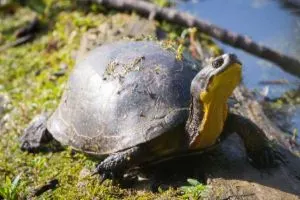
- Experience Level: Intermediate
- Family: Emydidae
- Scientific Name: Emydoidea Blandingii
- Other Names: N/A
- Adult Size: Between 5 and 8 inches
- Lifespan: Up to 80 years
- Average Price Range: Between $300 and $450
Named after naturalist William Blanding, these turtles have dark oval shells covered in yellow speckles.
Their plastrons are yellow with black patches. Blanding’s turtles are a also known as “the turtle that smiles”.
Blanding’s turtles are a species of concern in Michigan. Populations have been seen across the state despite threats to their preferred marshy habitats.
They are cautious, often diving to safety at any sign of trouble.
Blanding’s turtles are omnivorous, mainly eating crayfish, earthworms, and water-borne invertebrates.
They also occasionally eat plants, and do not rely on water to help them swallow unlike many other species of turtle.
2. Common Map Turtle

- Experience Level; Beginner
- Family; Emydidae
- Scientific Name; Graptemys Geographica
- Other Names: Northern Map turtle
- Adult Size; Between 4 and 10 ½ inches
- Lifespan; 15 to 20 years
- Average Price Range; Between $20 and $60
- Where To Buy; turtlestore.com
- Recommended Books; The Map Turtle and Sawback Atlas by by Peter V. Lindeman (Author), Anders G. J. Rhodin (Foreword)
Common Map turtles have dark brown or olive green shells, and are named for their markings, which resemble the contours of a map and are often yellow in color.
Small yellow spots behind the eyes separate the Common Map turtle from other subspecies.
Common Map turtles are relatively common in Michigan. They are a mainly aquatic species and rarely venture far from the water.
They do like to bask and are great swimmers.
These turtles are mainly carnivorous, feeding on fish and aquatic invertebrates like crayfish, but also occasionally eat plants.
3. Common Musk Turtle
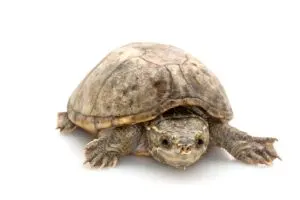
- Experience Level: Intermediate
- Family: Kinosternidae
- Scientific Name: Sternotherus Odoratus
- Other Names: Stinkpot, Eastern Musk turtle
- Adult Size: Between 4 and 5 inches
- Lifespan: 50 years and over
- Average Price Range: Between $20 and $90
- Where To Buy: theturtlesource.com, undergroundreptiles.com
Common Musk turtles are also known as “Stinkpots” due to the strong smell they can release from their musk glands, which they use to protect themselves from predators.
They are fairly common across Michigan.
Common Musk turtles have dark, unmarked shells. Their heads are also dark, with yellow lines along their faces. They prefer marshy and boggy habitats.
An omnivorous species, Common Musk turtles hunt for prey by scent. They mainly eat mollusks, crayfish, small fish, and tadpoles. They aren’t strong swimmers, so do not really chase prey.
4. Common Snapping Turtle
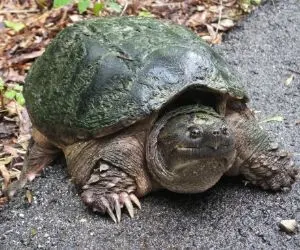
- Experience Level: Intermediate to Expert
- Family: Chelydridae
- Scientific Name: Chelydra Serpentina
- Other Names: Common Snapper, Eastern Snapping turtle, Snapper
- Adult Size: Between 8 and 20 inches
- Lifespan: Between 30 and 50 years
- Average Price Range: Between $20 and $40
- Recommended Books: Snapping Turtle Pet Owners Guide (Ben Team)
The largest amphibious turtles native to Michigan, Common Snappers can be found across much of the state.
They can be aggressive and will often hiss and bite. They inhabit almost any body of standing water.
Identified by their distinctive hooked “beaks”, Common Snappers usually have dark brown or green shells.
They also have relatively strong claws and long tails that sport saw-toothed ridges.
Common Snappers are nocturnal omnivores, mainly eating fish and other aquatic prey. They also consume underwater vegetation.
There have been some instances of Snappers eating small waterbirds if they get close enough.
5. Eastern Box Turtle
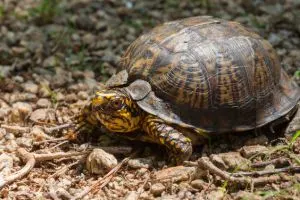
- Experience Level: Beginner
- Family: Emydidae
- Scientific Name: Terrapene Carolina Carolina
- Other Names: Land turtle
- Adult Size: Between 4 and 7 inches
- Lifespan: Up to 40 years
- Average Price Range: Between $120 and $400
- Recommended Books: Box Turtles: Complete Herp Care by Tess Cook
Eastern Box turtles are a species of concern in Michigan. Their high domed dark brown shells sport distinctive yellow and orange markings.
Their plastrons are also dark brown. Uniquely, Eastern Box turtles can regenerate their shells.
These terrestrial turtles can roam up to 50 meters a day in search of food. Eastern Box turtles are omnivores will eat fish and invertebrates as well as plants.
Eastern Box turtles prefer woodland as well as marshy and grassland areas and live near streams and ponds.
They are mainly confined to southwestern counties in Michigan.
6. Painted Turtle
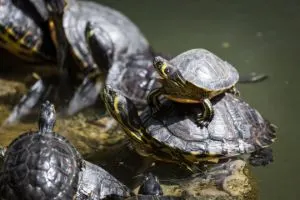
- Experience Level: Beginner
- Family: Emydidae
- Scientific Name: Chrysemys Picta
- Other Names: N/A
- Adult Size: Between 4 and 10 inches
- Lifespan: Between 30 and 50 years
- Average Price Range: Between $20 and $50
- Recommended Books: Painted Turtle Pet Owners Guide (Ben Team)
In Michigan there are two common native Painted turtle subspecies; the Midland Painted and the Western Painted.
A popular species of turtle to keep as a pet, Painted turtles have dark shells with faint yellow stripe markings.
Midland Painted turtles can be distinguished by a dark, shadow-like patch in the center of their plastrons.
Western Painted turtles have darker plastrons, with olive green shells.
Mainly an aquatic species, Painted turtles stay near the water and like to bask.
Painted turtles are omnivorous and mainly eat mollusks, frogs, and underwater invertebrates. They must swallow food in the water.
7. Red-eared Slider
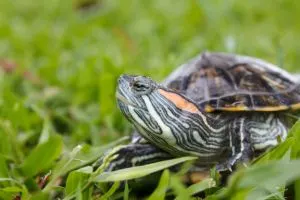
- Experience Level: Beginner
- Family: Emydidae
- Scientific Name: Trachemys Scripta Elegans
- Other Names: Water Slider turtle, Red-eared Terrapin
- Adult Size: Between 6 and 8 inches
- Lifespan: Between 20 and 40 years
- Average Price Range: Between $15 and $50
The Red-eared Slider is one of the most popular species of pet turtle on the market. In Michigan, this semi-aquatic species is confined to more localized pockets.
These turtles like to bask at the water’s edge, and often stack themselves upon each other.
Red-eared Sliders prefer warm, slow-moving waters. Their omnivorous diet consists of small fish, aquatic invertebrates, and underwater vegetation.
Red Eared Sliders commonly have an olive green shell, with yellowish striped markings on their scales.
Their heads are usually a darker color, with yellow band markings and red patches just behind their eyes.
8. Spiny Softshell Turtle
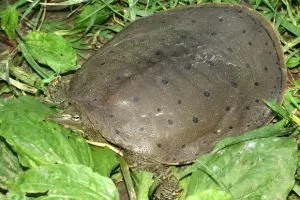
- Experience Level: Intermediate to Expert
- Family: Trionychidae
- Scientific Name: Apalone Spinifera
- Other Names: N/A
- Adult Size: 5 to 9 ½ inches for males, 7 to 17 inches for females
- Lifespan: Between 20 and 50 years
- Average Price Range: Between $70 and $280
- Recommended Books: Softshell Turtle Owners Guide by Ben Team
Spiny Softshell turtles have a pancake-like shell and sport several dark circles.
They feel like sandpaper to the touch. These turtles will scratch and bite if handled or caught. They have long, tubular beaks.
Spiny Softshells are mainly found in western areas of Michigan. They require a sandy habitat for burrowing and egg laying.
They are active during the day and bury themselves in the sand to sleep at night.
These turtles are fast swimmers. They are carnivores and will feed on any crustaceans, invertebrates, and mollusks they can find.
They also occasionally eat aquatic plants.
9. Spotted Turtle
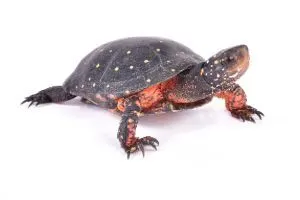
- Experience Level: Intermediate to Expert
- Family: Emydidae
- Scientific Name: Clemmys Guttata
- Other Names: N/A
- Adult Size: Between 4 and 5 inches
- Lifespan: Between 25 and 50 years
- Average Price Range: Between $75 and $100
- Recommended Books: BASICS – Ecology, Husbandry & Breeding Spotted & Wood Turtles by Andreas S. Hennig
Spotted turtles are a small, beautiful species, but are sadly threatened in Michigan. Their smooth shells are black, covered with their eponymous bright yellow dots.
Their plastrons are yellow with large black patches of varying sizes on either side.
These semi-aquatic turtles prefer shallower waters alongside marshy and boggy habitats. Spotted turtles like to bask, often perching themselves on logs by the water.
This omnivorous species often eats invertebrates, crustaceans, mollusks as well as vegetation.
Their small size makes them great pets. They are mainly found in Michigan’s southern counties.
10. Wood Turtle
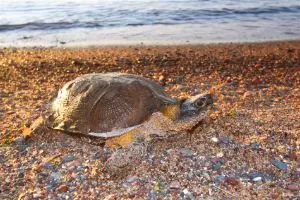
- Experience Level: Intermediate
- Family: Emydidae
- Scientific Name: Glyptemys Insculpta
- Other Names: N/A
- Adult Size: Between 5 ½ to 8 inches
- Lifespan: 40 years in the wild, 58 years in captivity
- Average Price Range: Between $249 and $495
- Where To Buy: The Turtle Source
- Recommended Books: Wood Turtles: A Pet Care Guide for Wood Turtles by Lolly Brown
Wood turtles are an intelligent species, but are a special concern species in Michigan due to declining numbers.
Their main habitats are woodlands and ponds.
They are active during the day and roam widely while looking for food. They are omnivores and often eat berries, plants, mollusks and earthworms.
They can trick worms into thinking it’s raining by rocking themselves to create vibrations in the soil.
Wood turtles are named because of their shells, which are rough and feel like they’re made of wood.
Their patterning looks similar to growth rings and wood grain. They are mostly brown in color.
Conclusion
In this list we’ve covered the ten native species of turtles in Michigan.
Some of the species we’ve examined are relatively common across the state, like the Common Musk turtle, whilst some unfortunate species are endangered or threatened, such as the Wood turtle.
If you enjoyed this list and are either looking to purchase one of these turtles as a pet or just discuss the list with other herp enthusiasts, feel free to comment below!
Other nearby states

dug
Thursday 13th of April 2023
you cannot even touch a blandings turtle in Michigan, they are protected.
Gammy Lucci
Tuesday 8th of November 2022
Looking to purchase a beginner turtle for my well rounded, mature 8 year old granddaughter. She's been asking for one since last Christmas, her birthday. Here we are again another Christmas and all she wants is a turtle. Is there any recommendations?
Brock Yates
Tuesday 8th of November 2022
I would recommend adoption over purchasing one. If you check our adoptions page and scroll to the bottom to the comments section there are plenty of people looking to rehome their turtles. https://www.allturtles.com/turtle-adoption/
Water turtles vs tortoises/box turtle care varies a bit as well as the space needs. You can check out the below two articles to see what species may be best for your granddaughter. Just be aware that turtles and tortoises have a long lifespan and do require regular maintenance, particularly with lighting and heating. https://www.allturtles.com/best-pet-turtles/ https://www.allturtles.com/best-pet-tortoises/
Tim
Sunday 8th of May 2022
I have a big rubber back turtle at my marina that has come back 10 years in a row always the 2nd or 3rd week of june and she eats hot dogs out of my hand, I have written down the dates every year this will be her 11th year if she comes which every june I worry if she will be back again, she spends the summer here and customers that come in for gas on there boat love watching there kids look at a turtle eating hot dogs. Have you ever heard of this, thanks Tim Mar-bil marine